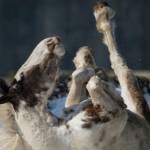Gastric Ulcers in Horses: A Widespread but Manageable Disease

Every equine practitioner appreciates the delicate nature of the equine gut. Problems related to the small intestine and large intestine are well understood and routinely treated. What may be surprising to many is how often the stomach is affected. Specifically, the incidence of gastric ulcers is extremely high, particularly in performance horses.
Many studies since the mid 1980’s have documented that gastric ulcers are commonplace in racehorses. An early postmortem study in Hong Kong(Hammond et al, 1986) of 195 Thoroughbred racehorses showed that 80% of the horses in active training had ulcers. The incidence of ulcers in horses retired from racing for one month or longer was 52%. Murray et al (1989) examined the stomachs of 187 horses ranging in age from one to 24 years. Eighty-seven horses had clinical problems including recurrent colic, poor body condition or chronic diarrhea. One hundred horses had no clinical signs of gastrointestinal problems. Ninety-two percent of the horses with clinical problems had gastric ulcers. Surprisingly, 52% of the horses displaying no clinical signs also had lesions.
Racehorses in training had a higher incidence of ulcers (89%) than non-racers (59%). More recently, two studies evaluated the incidence of gastric ulcers in California racehorses. In one postmortem study (Johnson et al, 1994) of 169 horses in training, 88% of Thoroughbred horses in training had ulcers. A gastroendoscopic study of 202 Thoroughbred horses in training showed that 81% had ulcers (Vatistas et al, 1994). Each of these studies revealed that 80% – 90% of racehorses in training have gastric ulcers. The vast majority of these lesions occur in the region of the stomach above the margo plicatus, with very few lesions in the glandular portion. The upper half of the horse’s stomach consists of squamous epithelial cells that are very similar to the tissue found in the esophagus. Ulcers in this part of the stomach are more similar to esophagitis (heartburn) in humans than the ulcers that occur in the glandular region of the human stomach. Research has shown that equine gastric ulcers are not caused by Helicobactor pylori bacteria which are a common cause of ulcers in humans.
Gastric Acid is a Major Cause
Dr. M.J. Murray of the Marion duPont Scott Equine Medical Center in Leesburg, Va., has proposed that the major cause of gastric ulcers in horses is prolonged exposure of the squamous mucosa to gastric acid. Unlike the glandular portion of the stomach, the squamous mucosa does not have a mucous layer and does not secrete bicarbonate onto its luminal surface. The only protection that this portion of the stomach has from gastric acid and pepsin comes from saliva production. If adequate saliva is not produced to buffer the gastric acid and coat the squamous epithelium, then gastric irritation occurs and lesions may develop.
The high incidence of ulcers seen in performance horses is a man-made problem resulting from the way that we feed and manage these horses, since ulcers are extremely rare in horses maintained solely on pasture. Horses evolved as wandering grazers with digestive tracts designed for continual consumption of forage. Meals of grain or extended periods of fasting lead to excess gastric acid output without adequate saliva production.
Horses secrete acid continually whether they are fed or not. The pH of gastric fluid in horses that were not fed for several hours has consistently been measured to be 2.0 or less (Murray, 1992). Horses that received free choice timothy hay for 24 hours had mean gastric pH values that were significantly higher than fasted horses (3.1 in fed versus 1.5 in fasted horses)(Murray and Schusser, 1989). Higher pH values in hay-fed horses should be expected since forage consumption stimulates saliva production. Meyer et al (1985) measured the amount of saliva produced when horses ate either hay, pasture or a grain feed. When fed hay and fresh grass, the horse produced 400-480 grams of saliva per 100 g of dry matter consumed. When a grainbased feed was offered, the horses produced only about half (206g/100 g dry matter) as much saliva.
Grains and pelleted concentrates also increase the production of gastrin, a hormone that stimulates gastric acid production (Smythetal, 1988). Hay fed alone affects gastrin production to a lesser degree. Therefore, horses that are fasted or that are fed high grain diets are more likely to produce more gastric acid with less saliva than horses offered free choice forage without grain.
It is easy to see why racehorses have such a high incidence of ulcers. Most horses in training are confined for most of the day and fed large grain meals. Often, racehorses are fasted for an extended period before exercise, allowing gastric acid to accumulate in the stomach.
Intense exercise further increases the production of gastric acid so that the squamous mucosa of the stomach gets thoroughly bathed in acid during work.
Treatment and Prevention of Ulcers
Treating ulcers involves either inhibiting gastric acid secretion or neutralizing the acid produced. There are three classes of drugs that can be used to inhibit gastric acid secretion:
1. Histamine type-2 antagonists (H2 antagonists).
H2 antagonists act by competing with histamine for histamine type-2 receptor sites on the parietal cell and therefore blocking histamine-stimulated gastric acid secretion. The two most popular H2 antagonists used in horses are cimetidine (Tagamet) and ranitidine (Zantac).
2. H+/K+ATPase inhibitors.
Direct inhibition of the proton pump can be achieved by substituted benzimidazoles. The only proton pump inhibitor licensed for horses in the US is omeprazole (Gastro Guard).
3. Prostaglandin analogues.
An alternative to suppression of acid production is to neutralize stomach acid and protect the squamous mucosa from exposure to acid. The natural buffering mechanism in the horse is saliva production and indeed the most effective way to treat ulcers is simply to turn the animal out on pasture. In situations where this is not possible, administration of antacids may be a useful adjunct to acid suppression therapy in horses.








